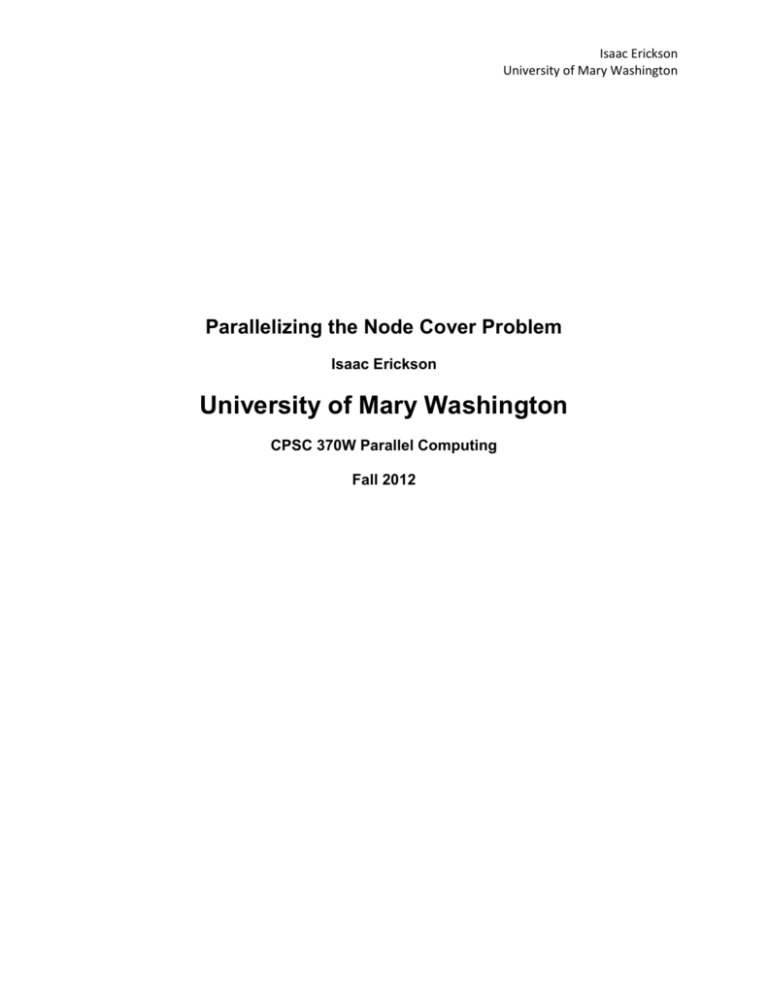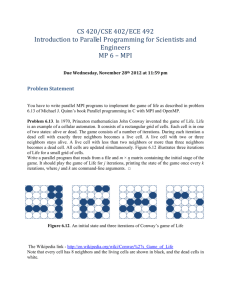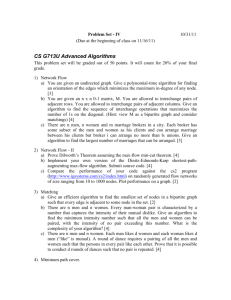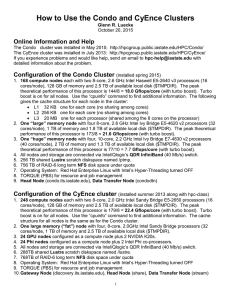Node Cover - Erickson, Isaac
advertisement

Isaac Erickson
University of Mary Washington
Parallelizing the Node Cover Problem
Isaac Erickson
University of Mary Washington
CPSC 370W Parallel Computing
Fall 2012
Isaac Erickson
University of Mary Washington
Parallelizing the Node Cover Problem
Isaac Erickson
CPSC 370W Parallel Computing
Fall 2012
For this project, my goal was to illustrate the differences in form and performance
for OpenMP and MPI. To do this I used the Node Cover NP complete problem (often
referred to as Vertex Cover) as a medium by which to run comparisons. Generally
speaking I found that as more CPUs are applied to the problem, the faster the task was
completed.
For the purpose of these experiments, we used the Node Cover NP complete
problem. As defined by Dr. Bin Ma, the University Research Chair at the University of
Waterloo:
Vertex Cover
- Instance: A graph G =< V,E >,
V = {v1, v2,…, vn}, E = {e1, e2, … , em}.
- Solution: A subset C ⊆ V, such that for any
ej = (va, vb) ∈ E, either va ∈ C or vb ∈ C.
- Objective: Minimize c = |C|.
In layman’s terms, this means that for any graph of size N, there can be found a
subset of N that satisfies the requirement that all vertices have at least one end that is a
member of that subset, and that that subset of N is the smallest possible subset while
still satisfying that requirement. To test this, I wrote three different versions of the same
algorithm to test them, a linear, an OpenMP, and a MPI version.
The base sequential version of my algorithm used a modified depth first search
to find the optimal subset of N recursively. I used a two dimensional array to represent
each node and their individual links to other nodes and an additional two arrays to keep
track of which nodes had been visited or covered in the current search. Then the
search was run using each individual node as a starting point to insure that all possible
configurations of the subset were examined. The actual subset was not saved, only an
integer representing the size of the subset |S ⊆ N|, because as I was using a randomly
generated tree for each test, the node covers were irrelevant, only the time it took to find
them. On testing with a single core on our class cluster, the problem exhibited
exponential growth. With only 500 nodes in the tree an answer was generated in just
under 30 seconds. With 1,000 nodes it took about 5 minutes. A 5,000 node test took
half an hour. When increased to 10,000 nodes the process took 13 hours, and with
2,000 added for a total of 12,000 nodes it took just over 23 hours to complete.
Isaac Erickson
University of Mary Washington
With the 12,000 node benchmark found using the cluster and BCCD, the same
algorithm was executed on Ranger which yielded a 21.75 hour completion time.
12,000 Nodes
10,000 Nodes
Ranger
5,000 Nodes
Linear Time
1,000 Nodes
500 Nodes
0
200
400
600
800
1000
1200
1400
1600
The first parallel version was created using OpenMP. Fortunately the
composition of the sequential version was such that it lent itself to being parallelized
very easily. Each iteration of the recursive algorithm had been called in turn for each
starting node from a “for” loop. All I had to do was place that “for” loop inside another
and specify what section of the tree each thread would be responsible for running
iteration for. In addition to this I had to move the primary array into global space. Using
OpenMP, I had trouble passing the private version to each individual thread. This led to
minor changes in the recursive function.
My OpenMP version was run three times for 12,000 nodes, twice on Ranger and
once on our class Cluster. The first execution on ranger seemingly failed. It exited out
of the process without returning any value for the minimum node cover set in just under
five seconds, meaning it created the random node tree and started the specified 16
threads, then exited out for un-known reasons. After it failed I ran a full blown test on
the cluster for 12,000 nodes for trouble shooting purposes. This finished in the
projected time of just under 2 hours with a good value for the node cover set. Then with
no changes to the code, it was run on Ranger again with a different compiler. That
execution did return a value for the node cover set, however it finished faster than
expected. It should have finished in time comparable to the class cluster results, but
instead it finished in exactly the same time as the 48 core MPI execution that we will
discuss next.
12,000 MPI48
Ranger
12,000 OpenMP
Cluster
0
2000
4000
6000
8000
Isaac Erickson
University of Mary Washington
Adapting the previous code for MPI was not difficult. After removing the OpenMP
code from the algorithm, the base MPI statements were inserted and a few
transmissions were added. The only tricky part was broadcasting the primary array to
all child processes from the primary process. On receipt of the broadcast, the child
process copies would be populated with only the memory locations for the pointers to
the second dimension arrays, the rest would be filled with garbage. To solve this I
broadcasted each second dimension array individually in a “for” loop.
The MPI version of my algorithm was executed three times on Ranger, for 16,
32, and 48 cores. All three were run with 12,000 nodes for input. The 16 core
execution completed in about 1 hour and 12 minutes. The 32 core finished more
quickly in 28 minutes, and the 48 core execution completed in 16 minutes.
Ranger
MPI 16
MPI 48
MPI 32
MPI 32
MPI 48
MPI 16
0
1000
2000
3000
4000
5000
6000
In most cases each parallel algorithm exhibited speed ups that were about the
same as the time to complete sequentially divided by the number of cores applied. The
only exception to this was the OpenMP execution on Ranger. The 16 core MPI
execution mathematically should have completed in no more then 1/16 th the time of the
sequential version, about one hour and twenty one minutes. It finished on Ranger in
one hour, twenty one minutes, and one second. The 32 core MPI execution finished
nine minutes slower than projected however. 1/32nd of the sequential version being 40
minutes, it finished in 49 and one half minutes. This was about a 19% loss in speedup.
The 48 core MPI execution however only lost about 4%, finishing in 28 minutes instead
of the expected 27 minutes. This was substantially less of a loss over its 32 core
counterpart. So the 16 core MPI version exhibited close to 100% efficiency, the 32
cores efficiency dropped to only 84%, and the 48 core efficiency came back up to 97%.
The OpenMP execution on our class cluster yielded a speedup of 11.68,
substantially less than the MPI16s which was at 16.21 for the same number of cores.
But these are two different systems. The problem is that the OpenMP execution on
Ranger finished at break neck speed, generating a 46.85 speedup. This is equal to the
MPI48 version. So ether Ranger is extremely efficient with managing threads, or only
about one third of the permutations for N were calculated.
From this data we gleam two important facts to remember for future testing.
One: that not all systems are equal. What runs on one can crash another or produce
random unpredictable results. Two: that there is a predictable overall decrease in
Isaac Erickson
University of Mary Washington
efficiency as the number of cores is increased, but efficiency can fluctuate along that
curve depending on the makeup of the algorithm.
In conclusion, both MPI and OpenMP are effective methods of performing tasks
in parallel. MPI appears to be more stable than OpenMP, probably because it creates
fully fledged copies of the main program that run independently rather than trying to
maintain control over multiple threads, insuring that the maximum size of any running
program is minimal. If one fails, all do not. Additionally there is predictability to the
speed up received by applying cores to both with regards to my algorithm, but the actual
results will fluctuate slightly.
This work was supported by the National Science Foundation through XSEDE
resources with grant ASC120039: "Introducing Computer Science Students to
Supercomputing in a Parallel Computing Course" and by the Texas Advanced
Computing Center, where the supercomputer we used is located. We wish to thank
XSEDE and TACC for their support
Thanks to Dr. Toth for providing superb instruction and a private cluster for class
use, and to the University of Mary Washington.
Depth-first search (DFS) for undirected graphs. (n.d.). Retrieved December 11, 2012, from Algorithms
and Data Structures: http://www.algolist.net/Algorithms/Graph/Undirected/Depth-first_search
Goldreich, O. (2010). P, NP, And NP-Completeness: The Basics Of Computational Complexity [e-book].
Ipswich, MA: Cambridge University Press.
Gusfield, D. (2007, Fall). ECS 222A - Fall 2007 Algorithm Design and Analysis - Gusfield. Retrieved
November 15, 2012, from UCDavis Computer Science:
http://www.cs.ucdavis.edu/~gusfield/cs222f07/tillnodecover.pdf
Lyuu, Y.-D. (2005). Prof. Lyuu's Homepage . Retrieved November 15, 2012, from National Taiwan
University: http://www.csie.ntu.edu.tw/~lyuu/complexity/2005/20050602.pdf
Ma, B. (n.d.). CS873: Approximation Algorithms. Retrieved October 23, 2012, from University of
Western Ontario: http://www.csd.uwo.ca/~bma/CS873/setcover.pdf
Muhammad, Dr. R. (n.d.). Department of Computer Science, KSU. Retrieved October 23, 2012, from Kent
State University:
http://www.personal.kent.edu/~rmuhamma/Algorithms/MyAlgorithms/AproxAlgor/vertexCover.htm
Vazirani, U. V. (2006, July 18). Retrieved December 02, 2012, from Electrical Engineering and Computer
Sciences UC Berkeley: http://www.cs.berkeley.edu/~vazirani/algorithms/all.pdf
Wayne, K. (2001, Spring). Theory of Algorithms "NP-Completeness". Retrieved December 08, 2012, from
Princeton University: http://www.cs.princeton.edu/~wayne/cs423/lectures/np-complete-4up.pdf








